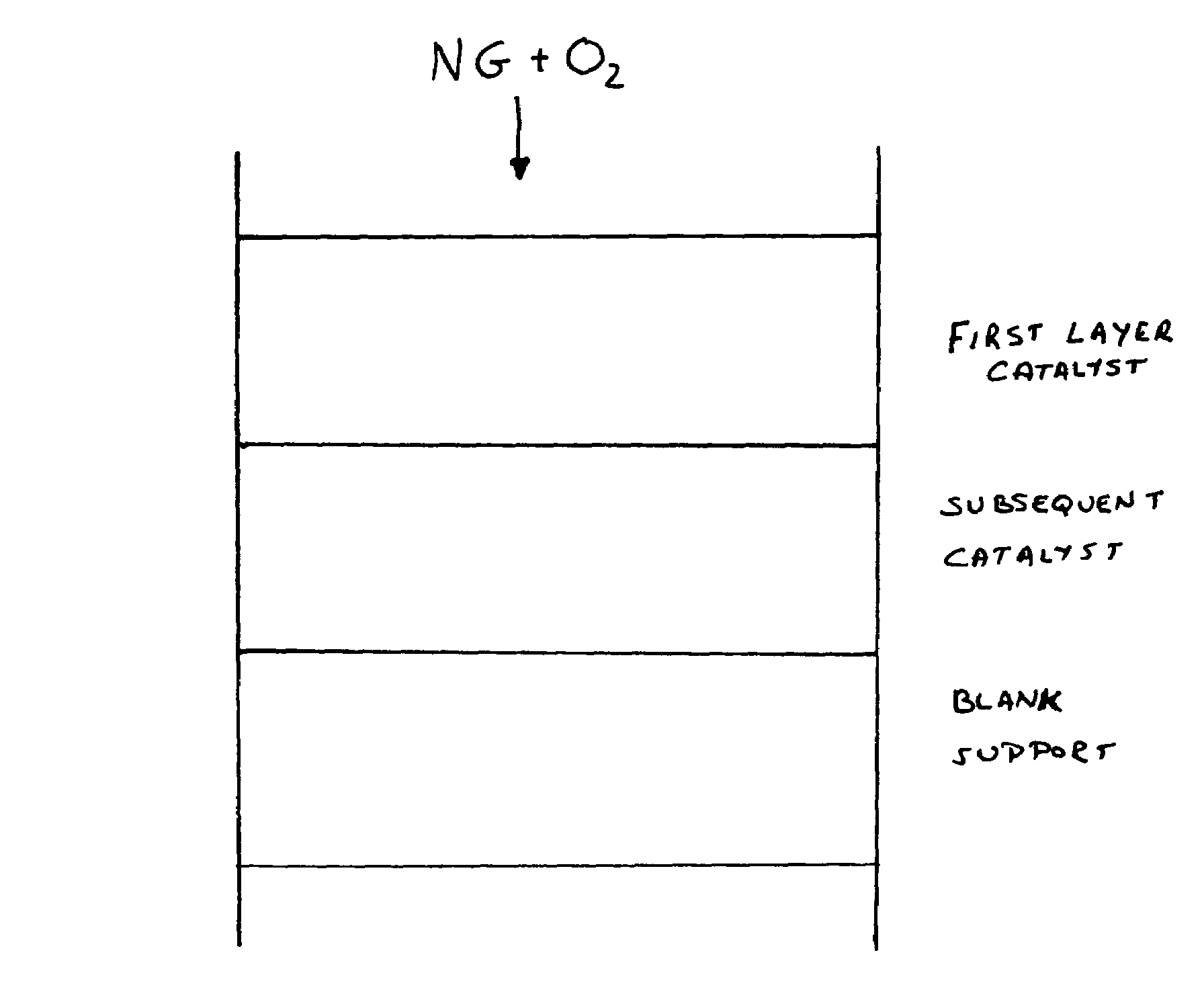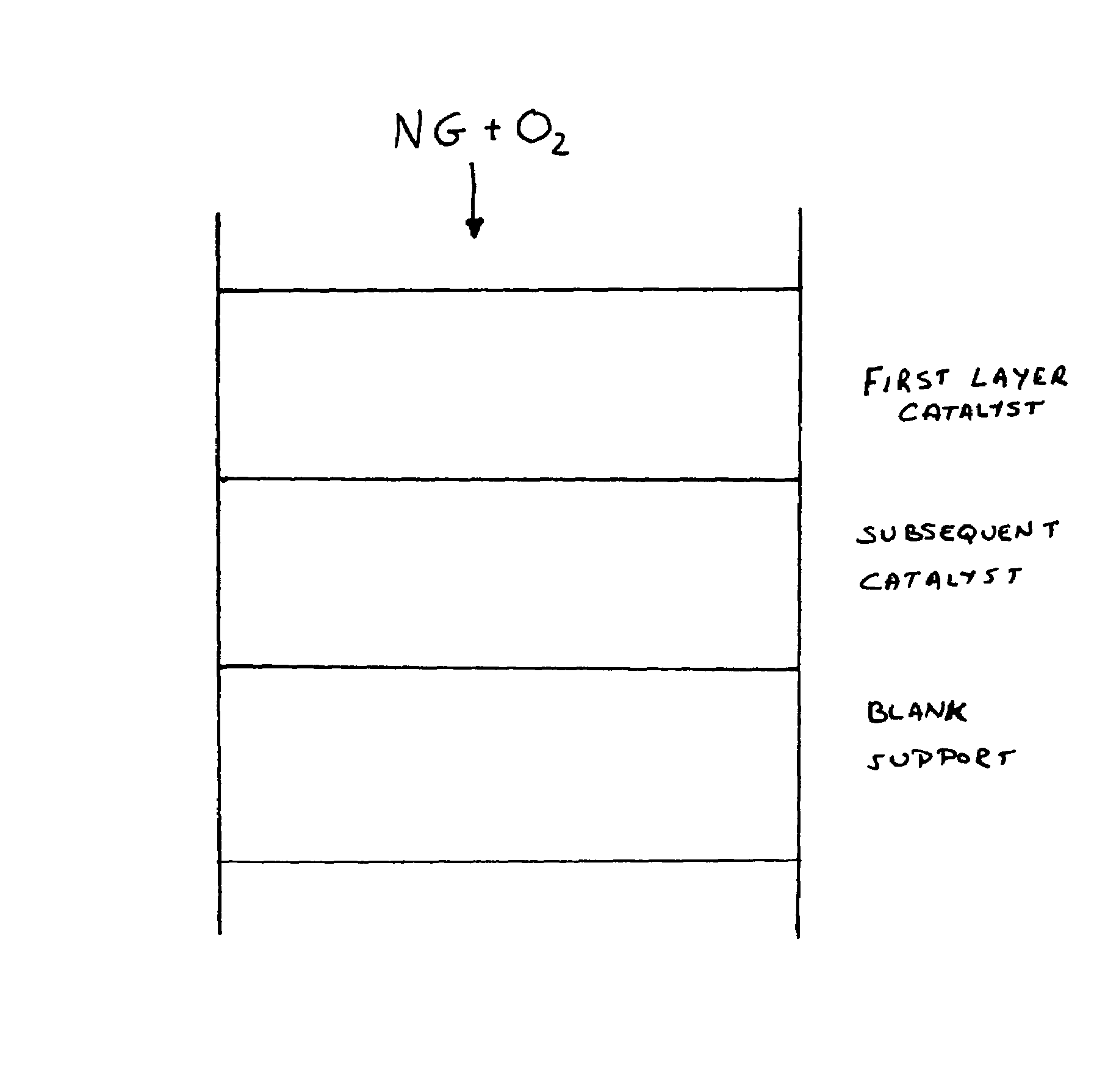Catalyst configuration and methods for syngas production
a technology of syngas and catalyst, applied in the direction of metal/metal-oxide/metal-hydroxide catalyst, machine/engine, etc., can solve the problems of catalyst disintegration, brittleness of the structure, and the operation of the partial oxidation process, so as to maintain the structural integrity and performance of the catalyst, good thermal and mechanical stability
- Summary
- Abstract
- Description
- Claims
- Application Information
AI Technical Summary
Benefits of technology
Problems solved by technology
Method used
Image
Examples
example 1
[0039]A 1 inch diameter and 0.4 inch thick cordierite honeycomb monoliths having 400 cells per square inch (cpsi) was impregnated with 2% by weight of rhodium. A feed mixture containing 64 volume % methane and 36 volume % oxygen was passed through the reactor containing above catalyst at a space velocity of 150,000 per hour. Within 10 minutes from start up, CH4 slip increased from 1% to 5%, no oxygen slip was observed. Product temperature increased from 900° C. to about 1200° C. The catalyst inspection after reaction indicated melting of the front layer of cordierite. This is in support of our understanding of higher temperature in the front due to exothermic reaction.
example 2
[0040]To further understand the reaction mechanism, a 1″ diameter and 1″ thick, large pore-size, ¼″αAl2O3 honeycomb was impregnated with 3% by weight of rhodium metal (Rh / Al2O3), labeled as ‘HC-1’. A feed mixture containing 64 volume % methane and 36 volume % oxygen was passed through the reactor. The total amount of feed mixture was maintained as in example 1. There was no deactivation of reaction performance over 5 hours of continuous operation. Higher product temperature, about 1200° C., compared with 900° C. typically observed for reticulate monolith only, was observed with carbon conversion of 70% and syngas selectivity of only 75%. No oxygen slip was detected. The used sample is still very strong with crush strength of more than 900 lbs.
[0041]To compare the effect of multi-layer configuration, a 1 inch diameter and 0.4 inch thick partially stabilized zirconia monolith, having 45 pores per inch, obtained from Vesuvius Hi-Tech Ceramics, was first washcoated with 20% ceria and th...
example 3
[0047]Low surface area (0.25 m2 / g) ¼ inch α-Al2O3 pellets were impregnated with 4% by weight of rhodium metal. To compare the long-term effect on the multi-layer configuration, a feed mixture containing natural gas and oxygen at a carbon to oxygen ratio of 1.73 was passed through the reactor with catalyst configuration of 1st layer of 0.4 inch thick Al2O3 pellet catalyst followed by 2nd layer of 1 inch length ST-1 monolith catalyst as in Example 2. The space velocity (S.V.) was 150,000 per hour, based on reticulate catalytic monolith only. This catalyst configuration remained in continuous operation for 6 months. There was no significant reduction in the catalyst performance or mechanical strength. The reactor outlet temperature was maintained at less than 800° C.
[0048]
RunningCH4H2COUsed sampleTimeConv.selectivityselectivityToutappearance 4 hrs93%93%95%650Both pellets and12 hrs90%94%94%720ST-1 monolith10 days91%95%94%680are as strong as 6 weeks90%94%94%650freshly prepared
PUM
| Property | Measurement | Unit |
|---|---|---|
| temperatures | aaaaa | aaaaa |
| pressure | aaaaa | aaaaa |
| linear velocity | aaaaa | aaaaa |
Abstract
Description
Claims
Application Information
 Login to View More
Login to View More - R&D
- Intellectual Property
- Life Sciences
- Materials
- Tech Scout
- Unparalleled Data Quality
- Higher Quality Content
- 60% Fewer Hallucinations
Browse by: Latest US Patents, China's latest patents, Technical Efficacy Thesaurus, Application Domain, Technology Topic, Popular Technical Reports.
© 2025 PatSnap. All rights reserved.Legal|Privacy policy|Modern Slavery Act Transparency Statement|Sitemap|About US| Contact US: help@patsnap.com


